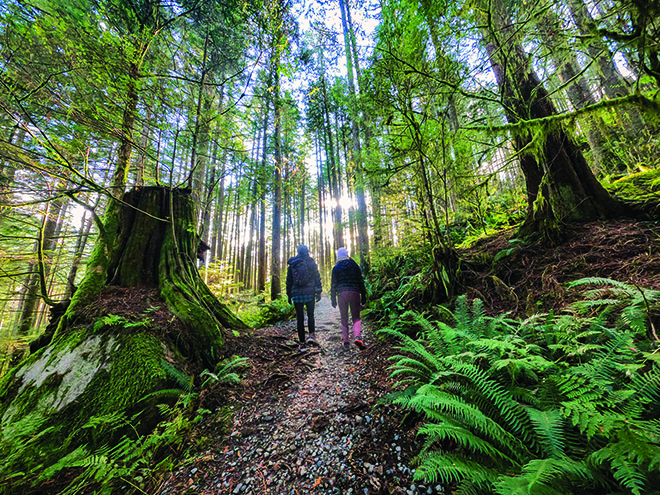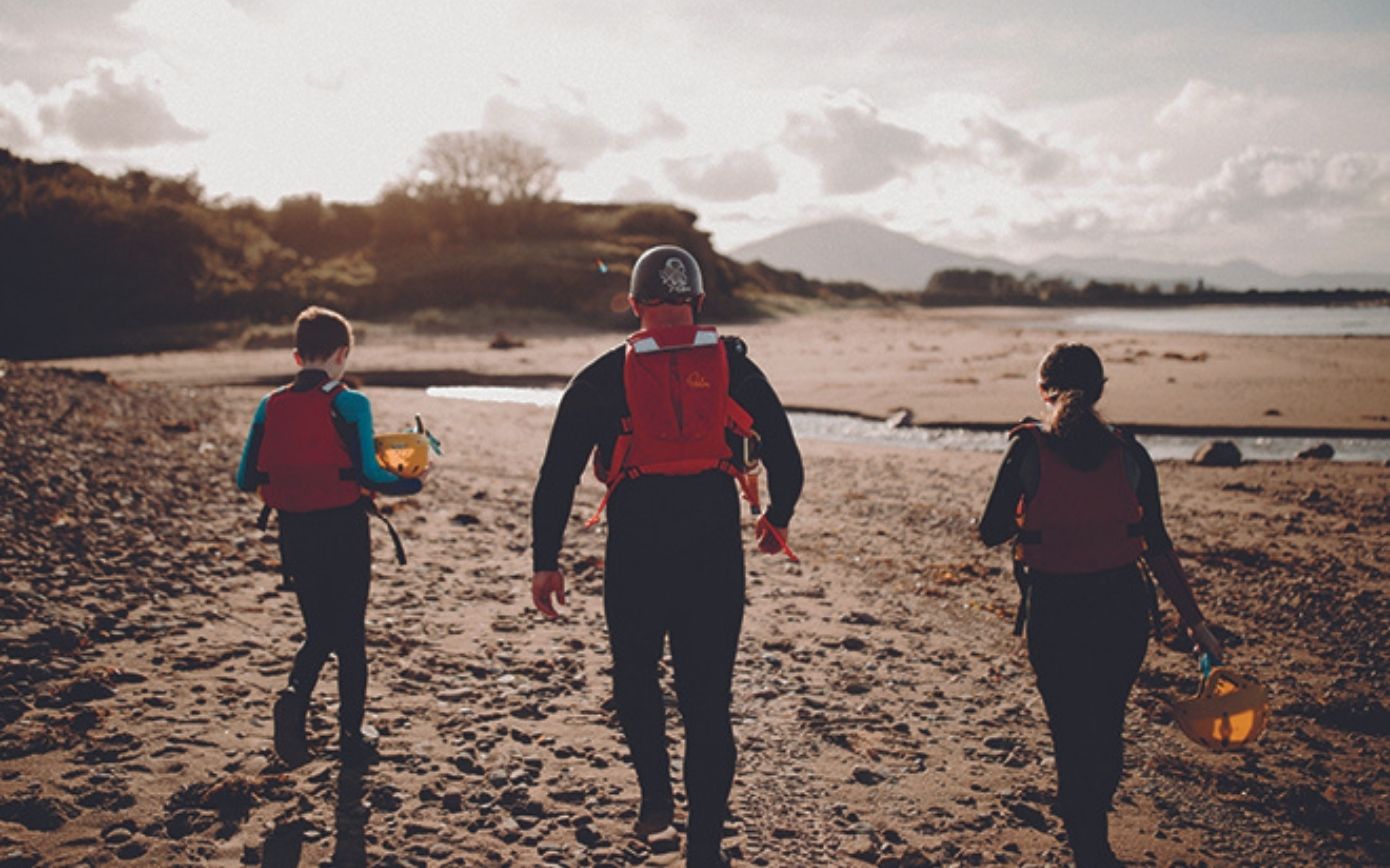Emily Hourican explores the idea of outdoor pyschotherapy …
Nothing in the therapy world is a “no- brainer”, but hearing an unlikely account of a young person who suffers with agoraphobia taking hikes with his therapist comes close.
In a society where the demand for mental health help is ever-growing, knowing advances are being made to render this help more effective, is reassuring. And those who have tried this kind of therapy – and it’s increasingly popular since Covid offered a binary choice, online, or outdoors – talk about the sense of calm and connection they feel.
Psychotherapist Joanne Hanrahan, based in Co Clare, recalls becoming aware of feeling “more reflective, more resourced, more present” when she spent time outdoors. This is what led her to do an MSc thesis on the integration of nature and psychotherapy, which led to her developing an outdoor therapy, supervision and training practice. During Covid, the uptake intensified. “First I was seeing all my clients online. Once restrictions eased, I offered all clients the option of online or outdoors.” One hundred per cent of her clients chose outdoors. “They jumped at the chance, even those who had never worked outdoors before.
“There have been many studies into outdoor interventions for people struggling with stress/burnout, particular illnesses and the effects of trauma. From my own extra studies into trauma and body psychotherapy, I can increasingly see the benefits of integrating nature into practice to help regulate the nervous system and symptoms, sensations, thoughts or behaviours associated with fight/flight and freeze responses.”
Hanrahan offers clients a menu of outdoor options to choose from, including working in the garden of the therapy room, for all or part of the session, or meeting off site. Sessions may consist of either walking or sitting at a particular sit spot.
How does she decide which approach to take? “I think about each client. Some clients may benefit by taking in a big vista – looking out to sea, down from a hill – while the nervous system of others may find this somewhat overwhelming and it may be better for them to focus small – into a rock pool, at a particular flowerbed.” She describes a variety of responses, depending on the location chosen. “In sessions by the sea, clients often mention feeling more enlivened and having an increased sense of freedom. Their bodies may feel more expansive as they recognise being part of a bigger landscape. Working in the woods on the other hand, or near a river, offers sensory experiences in what many regard as a comfortingly contained and secure environment. There is a vibrancy of colour, textures, movement, sounds and smells which help many clients develop mindful practice, somatic awareness, use of metaphor and ‘meaning-making’.”
Boundaries and psychological safety are hugely important with all therapy, Hanrahan explains, and need to be to the fore in the therapist’s mind when taking sessions away from the traditional frame of the room. “Working outdoors, just like all therapeutic work, is not a one-size-fits-all endeavour.”

Photograph via The New Wave Wild Project
The New Wave Wild Project, a not-for-profit social enterprise based in Tralee, Co Kerry, delivers adventure therapy interventions for young people, adults and families. Director Philip Stallard, an adventure therapist with experience in social work, CBT and psychotherapy, explains. “Our work is mainly with young people, especially those who are having social or emotional difficulties or behavioural issues, who are reluctant to go to traditional therapy.” Most, he says, may have already tried a few therapists or services, without much success.
Co-director Jasmin Stallard?s background is in education and psychology. “For families and small groups, we provide bespoke sessions, workshops and psycho-education programmes.” Typically, she explains, a session is four hours, one-to-one or in a small group, often a family group, exclusively in the outdoors, usually part of a programme of weekly sessions. “We get plenty of background information before we meet participants and we plan one main activity, either water or land-based, like kayaking, mountain biking, or hiking. We add shorter complementary activities and challenges that fit into the objectives for the session, bushcraft, hammocking or sand work, for example.”
Each activity, she explains, has a specific purpose. “It might open up a conversation, or help to demonstrate a theme, or present a challenge for the person. The idea of adventure therapy is to provide a kinaesthetic learning opportunity and a modality to introduce themes, and demonstrate and practise concepts.” It’s the kind of approach that requires flexibility, for various reasons. “Sometimes a person’s mood will necessitate a shift in the plan, and it’s important that we facilitate that.

“We incorporate a feedback-informed approach; it’s important to hear from the person themselves how the sessions are going and what they would like to do differently.” She gives the example of a young person who presented to New Wave Wild Project with experiences of trauma as a young child, attachment difficulties, who had been in the care system from a young age. This young person found it difficult to trust people, displayed challenging behaviour and was beginning to withdraw from school and friends. “They came for adventure therapy one-on-one at first, which helped to provide routine and structure and gave them a space to talk. They continued with sessions for almost a year and came a long way. They are back to education fulltime, playing sports again, communicating well with carers and professionals and report feeling a dramatic improvement in self-worth.”
For Sarah Hourigan of naturetherapyireland.com, who has a masters in applied psychology, it was a stint in health research for the HSE that showed her what she didn’t want to do. “I realised, this is not how I want to share my background in psychology. I lived in the countryside and have always been involved in hiking and walking. I saw firsthand the incredible healing benefits of nature and decided to merge my psychology background with that.”
She did a year-long course in wild therapy, specifically forest therapy, and now leads groups all over the country, including in Dublin’s Phoenix Park. “Since Covid, so many people are outdoors, swimming, cycling, running. The difference is that I want clients to slow down and connect with nature, rather than just moving through it. I create opportunities for healing encounters. We know, connecting with the natural world can lower heart rate and blood pressure, reduce cortisol and improve sleep, boost the immune system and accelerate recovery. Now it’s time to act on that.”

Who joins these group sessions? “People of all ages. Some are experiencing anxiety, and or depression, and for them, forest therapy works as a complementary therapy, alongside their doctor or psychiatrist. Also, those who are looking for a sense of community, who wish to tap into the emotional side of their lives.”
Sessions last for two hours, usually as part of a six-week course, and “the magic,” Hourigan says, tends to happen in week three or four. She encourages people to come alone rather than with a companion, in order to really open themselves up. “I plan a route of around half a kilometre. This is about moving slowly. We walk mostly in silence, and at four or five key spots, I offer targeted invitations to people to go a short way into the forest on their own, then come back into the circle and talk.”
It’s not just the benefits of nature itself. Outdoor therapy, Joanne Hanrahan points out, can greatly enhance the therapeutic relationship which, research shows, is the most important determinant of positive outcome from therapy. “Outdoors, the relationship is seen as less of a clinical one and more of a shared experience. Sometimes, outdoor work can help clients engage with a spiritual aspect of themselves. They may be more likely to get in touch with a fun or childlike aspect of themselves, which is really helpful to us all. There are also lots of benefits in terms of the extra information the therapist picks up about the client and the live processing that happens in the moment, that may not have surfaced in a clinical setting.”
If the misery of lockdown was to bring one lasting benefit, it may well be this: the blowing wide open of something deceptively simple and intuitive, that can also be disarmingly effective.
LOVETHEGLOSS.IE?
Sign up to our MAILING LIST now for a roundup of the latest fashion, beauty, interiors and entertaining news from THE GLOSS MAGAZINE’s daily dispatches.






